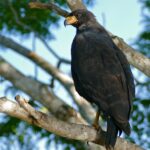Great Black Hawks (Buteogallus urubitinga) are large birds of prey known for their mostly black plumage, yellow legs, and yellow cere. While not migratory, Great Black Hawks in Argentina engage in some altitudinal migrations during the non-breeding season. Let’s explore how far these majestic birds travel from their nests.
The Nesting Habits of Great Black Hawks
Great Black Hawks build their nests in emergent trees or on power poles, typically laying one egg that hatches after 35-37 days of incubation. The nestling remains in the nest for about 40 days before fledging and stays with its parents for several months to learn hunting skills.
Altitudinal Migrations of Great Black Hawks
 Image source: Great Black Hawk by Bernard DUPONT
Image source: Great Black Hawk by Bernard DUPONT
While Great Black Hawks are not considered migratory birds, those found in Argentina do engage in some altitudinal migrations during the non-breeding season. This means that they move to different elevations, often to higher areas, in search of better foraging opportunities or more favorable environmental conditions.
The exact distance these birds travel during their altitudinal migrations can vary, but studies have shown that they may move up to several hundred kilometers from their nesting sites. For example, some Great Black Hawks in Argentina have been observed moving from lowland areas to higher-elevation regions in the Andes mountains during the non-breeding season.
Foraging Behavior and Hunting Ranges
Great Black Hawks have a varied diet, consuming a wide range of prey such as amphibians, fishes, lizards, snakes, birds, small mammals, crabs, large insects, carrion, and even fruits. To find these food sources, the birds employ various hunting techniques, including perching, walking on the ground, and even hunting near grass fires.
The hunting range of a Great Black Black Hawk can vary depending on the availability of prey and other environmental factors. Studies have shown that these birds can cover areas ranging from a few square kilometers to several dozen square kilometers in search of food.
Factors Affecting the Travel Distance of Great Black Hawks
Several factors can influence the distance Great Black Hawks travel from their nests, including:
- Prey Availability: If the prey is scarce or unevenly distributed near the nest, the birds may need to travel farther to find sufficient food.
- Habitat Fragmentation: Deforestation and other forms of habitat loss can force Great Black Hawks to travel longer distances to find suitable nesting sites and foraging areas.
- Seasonal Changes: As mentioned earlier, Great Black Hawks in Argentina may engage in altitudinal migrations during the non-breeding season, traveling to different elevations in search of better conditions.
- Disturbance and Human Activity: Increased human activity or development near nesting sites can cause Great Black Hawks to abandon their nests and search for new territories, potentially leading to longer travel distances.
Conclusion
While Great Black Hawks are not considered migratory birds, they can travel significant distances from their nests, especially during their altitudinal migrations in Argentina. The exact distance they travel can vary depending on factors such as prey availability, habitat fragmentation, seasonal changes, and human disturbance. Understanding the travel patterns of these impressive birds of prey is crucial for their conservation and the preservation of their natural habitats.
References:
- Great Black Hawk | The Peregrine Fund. (2021). Retrieved from https://peregrinefund.org/explore-raptors-species/hawks/great-black-hawk
- Hawks and Falcons – Game Commission – PA.Gov. (n.d.). Retrieved from https://www.pgc.pa.gov/Education/WildlifeNotesIndex/Pages/Hawks-and-Falcons.aspx
- Common Black Hawk | Audubon Field Guide. (n.d.). Retrieved from https://www.audubon.org/field-guide/bird/common-black-hawk


